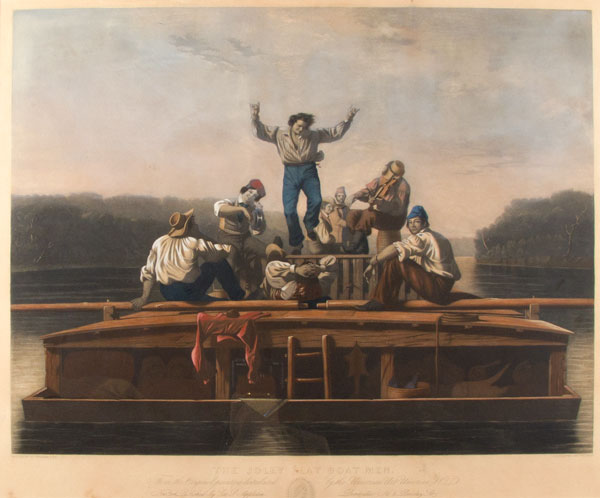Visions of the West
This exhibition brings together art from the mid-1800s to the present, acknowledging artists who made their images from the lens through which they saw the world. Ultimately they were influenced by time, place, and culture—and by the language of art. Through them we are invited to encounter the powerful idea of the west in various contexts, periods, and styles that reveal some part of the experience of others within the vastness of human life. This series of Director’s Tours Online seeks to share some details to peak your interest and invite you to see the works in person and learn more on your own.

This 1845 print is the exhibition’s earliest work. It was made around 20 years after some of the first renderings of western North America were recorded by expeditionary artists, who were hired to depict what they saw. Such proximity to these documentary renderings must have influenced George Caleb Bingham’s style and subject, which seems to me to both break from the art academy and draw on his personal life experience, mixing what he saw as someone who lived near a river and what he read in popular literature of the time.
Bingham was born in Virginia and moved with his family to the Missouri River near St. Louis. He studied art in Philadelphia in 1838 and was inspired by other artists painting scenes of everyday life, in contrast to academic painting. Nevertheless, he became a portrait painter until several years later turning to a subject he knew well, the river. Historian and retired museum director Ron Tyler tells us Bingham’s first river paintings held symbols that spoke about the perishing of one way of life and the ascendancy of another, from the perspective of the American 19th century.
The Jolly Flatboatmen was the first painting in Bingham’s flatboat series, based on “distinctly American types that had already emerged in literature.” (Tyler, 229) Evidently, river life and people were widely known and observed (literally, by people watching from the banks), but by the 1840s were changing with the spread of steamboats, giving this scene an air of nostalgia. The American Art-Union chose the painting, now housed at the National Gallery of Art in Washington, D.C., to have engraved by Thomas Doney and made 18,000 copies to distribute to its subscribers!
What do we see in this print? A shallow flat-bottomed boat floats on a serene, tree-lined river, while a group of men sit atop its roof at leisure. Bingham placed the boat in the center of the composition. The boat and men create a calming, almost ascending triangle that takes up most of the space of the print, such that we view it as if from the river bank as it passes or from another boat that trails behind it.
Two men play musical instruments. One dances. Two have their backs turned to us, and three look out, breaking the plane of the scene to lock eyes with us. Of these three, one’s expression is cunning and the other two grave. In what I’ve read about Bingham, it seems he was prone to imbue his compositions with symbolic commentary about American political life. The strangely direct gazes of these figures may suggest something telling about his time; or their gravity may simply refer to the loss of such lively and carefree scenes to the efficiency and industrialism of steam-powered boats.
Another detail catches my eye: the dancing figure (thought to be drawn from a description of a well-known flatboatman of the time) and the musician who faces us both have such delicate, small facial features — especially relative to their brawny bodies — as to appear doll-like and unreal. I find this odd for an artist with a foundation in portrait painting. Tyler gives a clue in a period description of Bingham’s potential model: “Long exposure to the sun and weather…had changed his skin; and, but for the fine European cast of his countenance, he might have passed for the principle warrior of some powerful tribe.” Perhaps another of Bingham’s subtle commentaries on contemporary life as he knew it.
Works consulted:
Goetzmann, William H. and Goetzmann, William N. The West of the Imagination. New York: WW Norton & Company, 1986.
Tyler, Ron. Western Art, Western History: Collected Essays. Norman: University of Oklahoma Press, 2019.
-
Tuesday - Friday
10:00AM - 5:00PMSaturday
1:00PM - 5:00PM